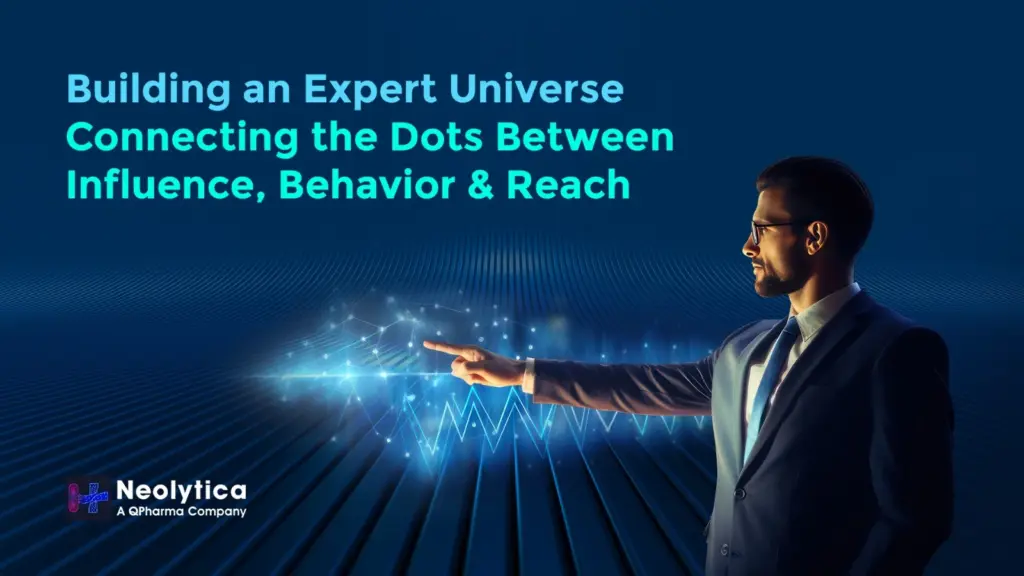Identifying and engaging Key Opinion Leaders (KOLs) requires more than just counting followers or publication citations. With rapid digitalization and innovation in the healthcare space, organizations need an “Expert Universe.”
An Expert Universe is a holistic map of clinicians, researchers, and digital opinion leaders whose combined influence, behavioral patterns, and audience reach can drive product adoption, inform clinical strategy, and shape brand perception. Here’s how to build that universe and turn scattered data points into strategic connections.
Defining Your Expert Universe
Your Expert Universe comprises three dimensions:
- Influence: Authority and credibility among peers, measured by publications, conference presentations, and digital thought leadership.
- Behavior: Engagement patterns, how often and where experts share insights, participate in forums, or collaborate on research.
- Reach: The size and quality of their audiences, from specialist communities to broader HCP networks and patient groups.
By integrating these dimensions, you move beyond simple lists of “top KOLs” to a dynamic network that reveals central connectors, emerging voices, and untapped micro-influencers.
Gathering Multichannel Data
To populate your Expert Universe, you need aggregated data from:
- Scientific Publications & Conference Proceedings (influence)
- Digital Platforms: Twitter, LinkedIn, specialist forums, and closed professional networks (behavior)
- Patient and Professional Networks: Webinars, advisory panels, and medical education platforms (reach)
Use automated tools to scrape mentions, track content engagement, and record event participation. Ensure compliance with privacy and industry regulations when accessing closed or semi-closed channels.
Mapping Who Actually Shapes the Conversation
When you map your Expert Universe, focus on signals that show how expertise flows and decisions get made:
- Collaboration patterns: Repeated co-authorships, multi-center trials, and shared panels point to trusted working relationships.
- Counsellors: Guideline contributors, session chairs, registry stewards, and advisory leads often set agendas for others.
- Practice-changing input: Remarks or slide decks that trigger internal debates, protocol tweaks, or field team follow-ups indicate real impact.
- Bridge voices: Experts active across academic and community settings or adjacent specialties help ideas travel faster.
- Topic focus and custom database: Define your priority therapy areas and build a curated, searchable expert database tagged by specialty, sub-topic, method focus, geography, and role. Keep it updated so outreach aligns with the exact clinical questions your teams are working on.
- Sentiment and trajectory: Track each expert’s tone by topic (supportive, neutral, skeptical) and how it changes over time. Watch for inflection points, e.g., sentiment shifting after a congress abstract or safety update, and pair those shifts with actions like field team requests.
- Timing and cadence: Selective commentary around congresses, data releases, or guideline cycles tends to carry more weight than frequent posts.
- Resonance signals: Saves, shares in HCP channels, and downstream requests for data or demos matter more than raw impressions.
Mapping with these cues, anchored to your medical topics, a customized expert database, and sentiment trends, helps find the connectors, amplifiers, and deep specialists who truly influence care, giving you a clear target list for outreach, advisory work, and collaborative planning.
Profiling Behavioral Patterns
Understanding when and how experts engage is important to unlock deeper insights:
- Frequency Analysis: Who publishes weekly LinkedIn posts or monthly journal articles?
- Channel Preference: Do they favor Twitter for live conference commentary, or specialized forums for in-depth case discussions?
- Interaction Style: Are they conversational, responding to peers’ questions, or do they primarily broadcast updates?
Behavioral profiles guide content strategy, ensuring that your medical affairs teams approach each expert in the right channel and format.
Measuring Digital Reach and Resonance
Digital KOLs are an important part of the Expert Universe. When including DOLs in your Expert Universe, reach and resonance are key factors. Reach isn’t just about follower counts. Some key parameters of evaluation are:
- Audience Composition: Percentage of followers who are practicing HCPs vs. patients or students.
- Engagement Quality: Comment-to-like ratios, depth of discussion threads, and referral traffic to professional resources.
- Amplification Potential: How often does their content get reshared by other influencers or professional bodies?
These metrics help prioritize experts who not only command attention but also mobilize their networks effectively.
Connecting the Dots for Strategic Engagement
With your Expert Universe mapped, you can:
- Segment Experts into clusters (therapeutic specialists, digital advocates, regional thought leaders) and create customized engagement plans for each group.
- Identify Bridge Experts who link disparate communities, ideal for cross-disciplinary initiatives or broad awareness campaigns.
- Spot Emerging Voices, micro-influencers with growing reach but high engagement rates. These are perfect for pilot programs or peer-to-peer education.
- Optimize Timelines by matching outreach to experts’ behavior patterns. For example, launch surveys when they’re most active, or schedule advisory calls after major publications.
Leveraging Technology to Scale Your Universe
The process of creating an Expert Universe that fits your organization’s goals and objectives is rigorous and meticulous. But with the help of platforms like Neolytica’s Ti-Expert, you can automate the end-to-end process:
- Data Aggregation: Pulls from publications, social media/digital platforms (over 100,000 sources), forums, and closed-loop channels in compliance-safe ways.
- Network Visualization: Presents interactive maps highlighting central hubs, bridges, and clusters.
- Behavioral Analytics: Tracks posting frequency, engagement styles, and channel preferences.
- Reach Metrics: Analyzes audience makeup, engagement depth, and amplification patterns.
With Neolytica, you get a customized Expert Universe that has been vetted by medical experts assisted by AI-ML algorithms. With customizable dashboards and automated alerts, your teams can keep the Expert Universe current and actionable.
Conclusion
Building an Expert Universe transforms raw data into a strategic resource, revealing who truly influences clinical decisions, how they behave, and how far their insights travel. By connecting the dots between influence, behavior, and reach, healthcare organizations can engage the right experts at the right time through the right channels.
Discover how Neolytica’s Ti-Expert platform can help you map and activate your Expert Universe. Visit neolytica.ai to learn more.

